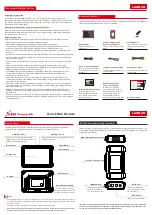
Safety Messages
6
Reliant
™
Light Bar
Federal Signal www.fedsig.com
• Never attempt to install aftermarket equipment that connects to the vehicle wiring,
without reviewing a vehicle wiring diagram available from the vehicle manufacturer.
Ensure that your installation will not affect vehicle operation or mandated safety
functions or circuits. Always check the vehicle for proper operation after installation.
• The lighting system components, especially light bulbs, strobe tubes, LEDs, and the
outer housing, get hot during operation. Disconnect power to the system and allow
the system to cool down before handling any components of the system.
• Halogen light bulbs and strobe tubes are pressurized and, if broken, can burst and
result in flying glass. Always wear gloves and eye protection when handling these
components.
• Do not mount a radio antenna within 18 inches of the lighting system. Placing
the antenna too close to the lighting system could cause the lighting system to
malfunction or be damaged by strong radio fields. Mounting the antenna too close to
the lighting system may also cause the radio noise emitted from the lighting system to
interfere with the reception of the radio transmitter and reduce radio reception.
• Do not attempt to wash this or any other electrical device while it is connected to its
power source. Exposure to liquid while the product is connected to the power source
may result in an electrical shock and personal injury and may short circuit and damage
the product.
During Installation and Service
• DO NOT get metal shavings inside the product. Metal shavings in the product can
cause the system to fail. If drilling must be done near the unit, place an ESD approved
cover over the unit. Inspect the unit after mounting to ensure there are no shavings
present in or near the unit.
• To avoid a battery explosion, always disconnect the negative battery cable first and
reconnect it last. Avoid causing a spark when connecting near or to the battery. The
gases produced by a battery can cause a battery explosion that could result in vehicle
damage and serious injury.
• DO NOT connect this system to the vehicle battery until ALL other electrical
connections are made, mounting of all components is complete, and you have verified
that no shorts exist. If the wiring is shorted to the vehicle body or frame, high current
conductors can cause hazardous sparks, resulting in electrical fires or flying molten
metal.
• DO NOT install equipment or route wiring (or the plug in cord) in the deployment path
of an airbag.
• If a vehicle seat is temporarily removed, verify with the vehicle manufacturer if the
seat needs to be recalibrated for proper airbag deployment.
• Before mounting any components, check the manual to verify that the component you
are installing is suitable for use in that area of the vehicle. Many components are not
suitable for use in the engine compartment or other extreme environmental exposure
areas.





































